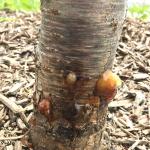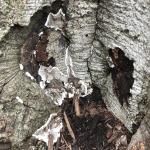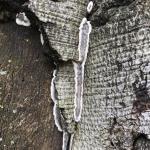UMass Extension's Landscape Message is an educational newsletter intended to inform and guide Massachusetts Green Industry professionals in the management of our collective landscape. Detailed reports from scouts and Extension specialists on growing conditions, pest activity, and cultural practices for the management of woody ornamentals, trees, and turf are regular features. The following issue has been updated to provide timely management information and the latest regional news and environmental data.
To read individual sections of the message, click on the section headings below to expand the content:
Scouting Information by Region
Environmental Data
The following data was collected on or about June 14. Total accumulated growing degree days (GDD) represent the heating units above a 50° F baseline temperature collected via our instruments for the 2017 calendar year. This information is intended for use as a guide for monitoring the developmental stages of pests in your location and planning management strategies accordingly.
|
Region/Location |
GDD |
Soil Temp |
Precipitation |
Time/Date of Readings |
||
|
1-Week Gain |
2017 Total |
Sun |
Shade |
|||
|
Cape Cod |
121.5 |
447 |
64 |
81 |
0.42 |
12:00 PM 6/13 |
|
Southeast |
115 |
433 |
80 |
64.5 |
0.07 |
5:00 PM 6/14 |
|
North Shore |
136 |
506 |
68 |
64 |
0.09 |
10:00 AM 6/14 |
|
East |
148.5 |
580 |
70 |
68 |
0.08 |
6:30 AM 6/13 |
|
Metro West |
141 |
532.5 |
69 |
63 |
0.07 |
5:45 AM 6/13 |
|
Central |
148 |
562 |
70 |
65 |
n/a |
6:20 AM 6/14 |
|
Pioneer Valley |
147 |
558 |
70 |
66 |
0.02 |
8:30 AM 6/14 |
|
Berkshires |
107 |
451 |
67 |
61 |
0.00 |
8:130 AM 6/14 |
|
AVERAGE |
133 |
509 |
70 |
67 |
0.09 |
- |
|
n/a = information not available |
||||||
Drought Conditions Update: All of Massachusetts (100%) is not under official drought status at this time. For more information see http://droughtmonitor.unl.edu/Home/StateDroughtMonitor.aspx?MA
Phenology
| Indicator Plants - Stages of Flowering (BEGIN, BEGIN/FULL, FULL, FULL/END, END) | ||||||||
|---|---|---|---|---|---|---|---|---|
| PLANT NAME (Botanic/ Common) | CAPE | S.E. | N.S. | EAST | METRO W. | CENT. | P.V. | BERK. |
| Ligustrum spp. (Privet) | * | Begin | * | * | * | * | Begin | * |
| Catalpa speciosa (Northern Catalpa) | * | Begin/Full | Begin | * | Begin | * | * | * |
| Syringa reticulata (Japanese Tree Lilac) | Begin | Begin | Begin | Begin | Begin/Full | Begin | Full | Begin |
| Cladrastis lutea (Yellowwood) | Begin/Full | End | Full | Full/End | Full | Full | End | Full |
| Philadelphus spp.(Mockorange) | Full | Full | Full | Full | Full | Full | Full/End | Full |
| Hydrangea anomala petiolaris (Climbing Hydrangea) | Begin | Full | Begin/Full | Full | Begin/Full | Begin/Full | Full | Begin/Full |
| Kalmia latifolia (Mountain-laurel) | Begin/Full | Full | Full | Begin | Full | Begin | Full | Full |
| Cotinus coggygria (Common Smokebush) | Full | Full | Full | Full | Full | Full | Full | Full |
| Cornus sericea (Red Osier Dogwood) | * | * | Full/End | End | Full | Full | Full | Full |
| Robinia pseudoacacia (Black Locust) | Full/End | End | End | * | End | End | End | Full/End |
| Kolkwitzia amabilis (Beautybush) | Full/End | Full | Full | Full/End | Full | Full | Full/End | Full |
| Weigela florida (Old Fashioned Weigela) | Full/End | Full/End | Full | Full/End | Full | Full | Full/End | Full/End |
| Deutzia spp. (Deutzia species) | Full/End | End | Full/End | End | Full | * | End | Full/End |
| * = no activity to report/information not available | ||||||||
Regional Notes
Cape Cod Region (Barnstable)
General Conditions: The average temperature from June 7 - June 14 was 68° F with a high of 92.5° on June 13 and a low of 42° F on June 8, a significant temperature spread for the week. The temperature exceeded 90° F on both June 12 & June 13 - somewhat of a rarity on Cape Cod. The week had little precipitation (0.42 inches) most of which fell on June 9. On June 13 there were some isolated thunderstorms. The rapid warm up and plentiful sun caused many plants to wilt even under adequate soil moisture. Topsoil moisture is short, subsoil moisture is adequate.
Pests/Problems: Gypsy moth caterpillars continue to feed on susceptible hosts. Caterpillars are primarily in the fourth instar. Defoliation on the upper Cape is spotty with areas rapidly expanding as we approach the larger later instars. Viburnum leaf beetle larvae have begun to drop to the ground to pupate. Other active insects include Bristly nose roseslug sawfly, columbine sawfly, hydrangea leaftier, four lined plant bug, and earwigs. Sycamore anthracnose in many instances has blighted the trees’ first attempt to leaf out. Maple anthracnose is being seem in some spots. Brown rot damage is extensive on Kwanzan and other ornamental cherries. Weeds in bloom include; black medic (Medicago lupulina), multiflora rose (Rosa multiflora), buckthorns (Rhamnus & Frangula), black swallow-wort (Cynanchum louiseae), white campion (Silene alba), white clover (Trifolium repens), hawkweed (Hieracium pratense), red sorrel (Rumex acetosella), curly dock (Rumex crispus), goutweed (Aegopodium podagraria) and yellow woodsorrel (Oxalis stricta).
Southeast Region (Hanson)
General Conditions: Summer came hard and fast after the previous cooler weather. Temperatures were in the high 80’s on June 11, and the low 90’s on June 12, and 13. High heat pushed many plants to end bloom prematurely and soils in sunny areas are drying out, while soils in the shade remain moist. Hanson received a trace amount of rain at 0.07 inches. Remind clients to water newly planted or transplanted plants and those plants defoliated by caterpillars.
The following plants are in bloom: Sinocalycanthus chinensis, Aesculus x carnea, Liriodendron tulipifera (Tuliptree), Cornus kousa, Magnolia virginiana (Sweetbay magnolia), Styrax japonicus, Weston hybrid azaleas, Hydrangea anomala petiolaris, Itea virginica, Spiraea sp., Rhododendron sp., Kalmia, Calycanthus floridus (Common Sweetshrub), Indigofera sp., landscape roses, Rosa rugosa, Clematis sp., Viburnum dilatatum (Linden Viburnum), Viburnum dentatum (Arrowwood Viburnum), Syringa x prestoniae ‘James MacFarlane’, Clematis, Robinia hispida (bristly locust), Beautybush, Lonicera sempervirens, Lonicera ‘John Clayton’, early daylilies, Alchemilla mollis, Salvia sp., Geranium sp., Thalictrum aquilegifolium, Anenome canadensis, Persicaria polymorpha, Doronicum sp., Lamium, Allium, Nepeta sp., Baptisia australis, Dianthus sp., Tradescantia, Lupines, Corydalis lutea, Valeriana officinalis, Amsonia sp. Foxgloves,Peonies, Aquilegia (Columbine) and Oriental poppies. A Rosa rugosa hybrid, ‘Linda Campbell’ is in full bloom; double red flowers on a plant 4-6 feet high and wide; usually no problem with black spot and blooms again later in the season. It is worth checking out.
Cotinus obovatus (American Smoketree) and Cotinus coggyria (European Smokebush) have ended bloom but are now producing their colorful “smoke” (plume-like hairs that form on the sterile flowers). The ‘smoke’ is an attractive landscape feature and will remain for several weeks. Chionanthus virginicus, Physocarpus opulifolius (Eastern Ninebark, Siberian Iris and bearded iris are ending bloom.
Hanson is at 1,149 GDD - Growing Degree days, Base 40.
Pests/Problems: Gypsy moth caterpillar damage appears to be sporadic. Some trees in some areas are stripped of foliage and others have little damage. At our Hanson site, there are several trees that are monitored for caterpillar damage and the large oak tree, along with the apple and crabapple trees, are almost stripped of foliage. These trees are traditionally damaged by winter moth caterpillars, but this year there was little damage by winter moth but gypsy moth caterpillars came in and stripped the leaves. Most gypsy moth caterpillars are in 4th instar; however at another site in Hanson, there were numerous 5th instar caterpillars. Along with the 4th and 5th instar caterpillars, there were many 2nd - 3rd instar small caterpillars. I asked Dr. Elkinton’s staff about that, and the answer is that the caterpillars were parasitized by a small wasp Cotesia melanoscela (http://www.entomology.wisc.edu/mbcn/kyf503.html). The parasitized caterpillars will not molt into 4th, 5th or 6th instar as a result. In areas where caterpillar numbers are high, falling frass (excrement), can clearly be heard 24 hours a day and the frass is covering everything below. Many caterpillars were observed climbing up buildings and dying, but many others appeared healthy and remain feeding. Again, the highest caterpillar numbers were found feeding on oak. For detailed Gypsy Moth information, see the Insect Section of the Landscape Message below.
Asiatic garden beetles have started to emerge and these small copper-colored beetles feed on a wide range of plant material and are often attracted to lights and feed at night. The larger copper colored beetle, European chafer, is also active.
Birch leaf miner, Fenusa pusilla, is active on grey birch and paper birch. Look for small brown lesions on the foliage. Hold the leaf to the light and you may see the small sawfly larvae feeding within the leaf. Slugs, snails and earwigs are active and are often found feeding on plant material at night. Golden tortoise beetle is feeding on sweet potato vine. Euonymus caterpillars have finished feeding and have pupated.
The following insects remain active: lacebugs on Japanese Andromeda (Pieris japonica), Rhododendron and azaleas; roseslug sawfly; White pine sawyer beetle (Asian longhorned beetle look-alike); cottony camellia scale on Merserve hollies and Taxus; Hemlock woolly adelgid; elongate hemlock scale; Taxus mealy bug; mosquitoes, aphids, stink bugs,four-lined plant bugs, leafhoppers, lily leaf beetle, wasps, pine spittlebugs, azalea whitefly, hornets, deer flies, horse flies, dog ticks and deer tick nymphs. Beneficial insects are active and it is a great year for butterflies.
The following plant diseases continue to be observed: sycamore anthracnose; maple anthracnose; dogwood anthracnose; black spot on roses; apple scab on crabapples and apples;Phyllosticta hamamelidis (Witchhazel blight) on ‘Arnold Promise’ witchhazel; Monilinia (brown rot) on Kwanzan cherry; botrytis blight on peonies.Continue to remove Azalea leaf galls (Exobasidium vaccinii) from deciduous azaleas and place them in the trash.
The following weeds are in bloom: Multiflora rose (Massachusetts invasive plant); oxeye daisy; black swallowwort (invasive); hawkweed; buttercup; veronica.White pines have finished producing pollen. Now all we need is a good downpour to clean off all the yellow pollen that is everywhere.
North Shore (Beverly)
General Conditions: We started the first few days of this reporting period with seasonable temperatures in the low 70s on June 7th and 8th. The temperatures climbed steadily into the low to mid 80s on the 9th and the 10th and by June 11 the heat was on with temperatures climbing into the mid to high 90s with high humidity. We gained 126 growing degree days during this period. It was also dry except for June 13 when approximately 0.09 inches of rain were recorded at Long Hill, Beverly. Soil moisture was still adequate due to previous rains except for areas with sandy soils where the top moisture was inadequate and necessitated watering for some plants . Woody plants seen in bloom include: Chinese dogwood (Cornus kousa), Arrowwood viburnum (Viburnum dentatum), Magician Deutzia (Deutzia magicien), Fringe tree (Chionanthus virginicus), Mock orange (Philadelphus spp.), Beautybush (Kolkwitzia amabilis), Mountain Laurel (Kalmia latifolia), Weigela (Weigela florida), Korean dogwood (Cornus coreana), Stewartia (Stewartia rostrata), Chinese stewartia (Stewartia serrata), American holly (Ilex opaca), Japanese snowbell (Styrax japonica), and Yellowwood (Cladrastis kentukea). Non-woody plants seen in bloom include: Bush Cinquefoil (Potentilla fruticosa), Foam flower (Tiarella cordifolia), Fetterbush (Leucothoe fontanesiana), Scotch rose (Rosa spinosissima), Peony (Paeonia sp.), Cranesbill (Geranium sp.), Bleeding heart (Dicentra spectabilis), Redleaf rose (Rosa glauca), Rodger's flower (Rodgersia aesculifolia), Goat’s beard (Aruncus dioicus), Japanese primrose (Primula japonica), Water lily (Nymphaea odorata), Columbine (Aquilegia spp.), Sweet woodruff (Galium odoratum), and annuals such as petunia and million bells.
Pests/Problems: Skeletonized leaf damage by viburnum leaf beetle was observed on Arrowwood viburnum and American cranberry viburnum. Apple scab lesions were observed on leaves of some crabapple trees. Also observed were black spot (Diplocarpon rosae) fungal leaf spots on leaves of some roses. Multiflora rose (Rosa multiflora) is in full bloom and can be seen growing in and amongst trees and shrubs. Several weeds are in bloom. Take steps to control these weeds before they set seed. Ticks and mosquitoes are very active. Make sure you protect yourself with appropriate repellants before you go out into areas with vegetation, especially out in the woods.
East Region (Boston)
General Conditions: Temperatures have steadily climbed over the last week. We began with a high of 67° F on the 7th, warming to the high 70’s on the 8th and 9th before reaching into the 90’s on the 11th, 12th and 13th. This marked the second heat wave of the year and summer has yet to begin! We received only 0.08 inches of precipitation, which fell during a fast moving downpour on the 9th and on the evening of the 13th. We have gained 148.5 GDDs over the last week bringing us to 580.0 GDDs. Many plants are in bloom including: Alchemilla mollis (lady's mantle), Amsonia hubrichtii (Hubricht's bluestar), Aquilegia canadensis (Eastern red columbine), Coreopsis sp. (tickseed), Cornus coreana (Korean dogwood), Cornus kousa (Kousa dogwood) Rutgers hybrids, Digitalis sp. (foxglove), Hydrangea heteromalla (Himalayan hydrangea), Iris germanica (bearded iris), Iris sibirica (Siberian iris), Lamium maculatum 'White Nancy' (dead nettle), Lamprocapnos spectabilis (bleeding heart), Leucanthemum vulgare (oxeye daisy), Lupinus perennis (wild lupine), Nyssa sylvatica (blackgum), Platycodon grandiflorus (balloon flower), Potentilla fruticosa (bush cinquefoil), Rosa canina (dog rose), Rosa pimpinellifolia (scotch rose), Rosa virginiana (Virginia rose), and hybrid roses including Carefree Beauty, Double Knock Out, ‘Julia Childs’, and ‘Mister Lincoln’ among many others, Sambucus nigra (black elderberry), Spiraea japonica (Japanese meadowsweet), Trifolium pratense (red clover), Trifolium repens (white clover), Viburnum plicatum f. plicatum 'Mary Milton' (pink Japanese snowball) and Wisteria sp. (wisteria). Populus deltoides (eastern cottonwood) and other poplars have let their seed fly, leaving fluffy cotton accumulations on the ground.
Pests/Problems: Precipitation followed by recent hot temperatures has contributed to many landscape weeds gaining in size including Convolvulus arvensis (field bindweed), Conyza canadensis (horseweed), and Fallopia japonica (Japanese knotweed). Seedlings of Ampelopsis brevipedunculata (porcelainberry), Cynanchum louiseae (black swallowwort), and Vitis spp. (grape) have germinated in sunny areas. Rumex crispus (curly dock) and Rumex obtusifolius (bitter dock) are setting seed. Weeds currently in bloom include Cynanchum louiseae (black swallowwort), Lepidium virginicum (Virginia pepperweed), Medicago lupulina (black medic), Plantago lanceolata (narrowleaf plantain), Rubus spp. (wild bramble), Solanum dulcamara (bittersweet), Tradescantia virginiana (Virginia spiderwort), Trifolium pratense (red clover), Trifolium repens (white clover), and Urtica dioica (stinging nettle). Galls are present on the leaves of many hickories. Azalea bark scale (Eriococcus azaleae) is actively laying eggs on Rhododendron vaseyi (pinkshell azalea). Euonymus webworm (Yponomeuta cagnagella) is actively feeding on the leaves of Euonymus pauciflorus as the silken webs are easily spotted. Horsechestnut leaf blotch (Guignardia aesculi) lesions are beginning to appear on Aesculus sp. (horsechestnut). Black spot (Diplocarpon rosae) is visible on the leaves of many Rosaceous trees and shrubs including Amelanchier sp. (serviceberry) and Malus sp. (crabapple and apple). Allergies have been severe over the last week; possible culprits are Carya sp. (hickory) and Quercus sp. (oak) which continue to flower.
Metro West (Acton)
General Conditions: A week ago, in my landscape message, I wrote about the lack of warm and sunny temperatures and now less than a week later, we have experienced a run of 3 days with 90° plus temperatures and I found myself going from turning the heat on in the house to turning on fans and the air conditioner to keep things cool. We’ve gone from early spring-like temperatures to mid-summer like temperatures during this reporting period with hot and dry weather. The historical monthly average rainfall for June is 3.93” and the total for the month so far is now at 2.24”. There was little gain in precipitation; let’s hope that this is not a trend; but much gain in GDD. Woody plants seen in bloom this past week are Catalpa speciosa (Northern Catalpa), Chionanthus retusus (Chinese Fringe Tree), C. virginicus (Fringe Tree), Cladrastis kentukea (Yellowwood), Cornus kousa (Kousa Dogwood), C. sericea (Red Osier Dogwood), C. x rutgersensis 'Ruth Ellen' (Rutgers Hybrid Dogwood), Cotinus coggygria (Common Smokebush), Kalmia latifolia (Mountain Laurel), Kerria japonica (Japanese Kerria), Kolkwitzia amabilis (Beautybush), Leucothoe axillaris (Coast Leucothoe), Philadelphus coronarius (Sweet Mock Orange), Physocarpus opulifolius (Common Ninebark), P. opulifolius 'Summer Wine' (Summer Wine Ninebark), Potentilla fruiticosa (Potentilla), Rosa rugosa (Rugosa Rose), R. 'Knockout' (The Knockout family of Roses), Rosa spp. (Rose), Rubus spp. (Bramble, Blackberry), Spirea japonica 'Alpina' (Daphne Spirea), Spiraea spp. (Spirea), Syringa reticulata
(Japanese Tree Lilac), Viburnum cassinoides (Witherod Viburnum), V. dentatum (Arrowwood Viburnum), V. plicatum var. tomentosum (Doublefile Viburnum), V. sargentii (Sargent's Viburnum) and Weigela florida (Old Fashioned Weigela). Woody vines in bloom are: Clematis spp. (Clematis), Hydrangea anomala petiolaris (Climbing Hydrangea), and Lonicera sempirvirens (Trumpet Honeysuckle). Contributing even more color and interest to the landscape are some flowering herbaceous plants including: Achillea millefolium (Yarrow), Ajuga reptans (Bugleweed), Alchemilla mollis (Lady's Mantle), Allium giganteum (Giant Onion), A. schoenoprasum (Chives), Amsonia hubrichtii (Arkansas Blue Star), Aquilegia spp. (Columbine), Baptisia australis (False Blue Indigo), Campanula takesimana ‘Elizabeth’ (Bell Flower), C. spp. (Bell Flower), Centaurea montana (Cornflower), Chrysogonum virginianum (Green and Gold), Clematis recta 'Purpurea' (Clematis), Coreopsis spp. (Tickseed), Dianthus deltoides (Maiden Pink), Dicentra eximia (Fringed Bleeding Heart), D. spectabilis (Old Fashioned Bleeding Heart), D. spectabilis 'Alba' (White Flowering Old Fashioned Bleeding Heart), Dictamnus albus (Gas Plant), Filipendula sp. (Meadow Sweet), Geranium cantabrigiense 'Biokovo' and 'Cambridge' (Hardy Cranesbill), G. macrorrhizum (Bigroot Geranium), G. sanguineum (Cranesbill Geranium), Hemerocallis spp. (early blooming Daylily), Heuchera spp. (Coral Bells), Hosta spp. (Plantain Lily), Iris germanica (Bearded Iris), I. sibirica (Siberian Iris), Leucanthemum sp. (Shasta Daisy), Lupinus 'Russell Woodfield Hybrids' (Lupine), Nepeta spp. (Ornamental Catmint), Paeonia spp. (Peony), Papaver (Poppy), Perovskia atriplicifolia (Russian Sage), Phlox divaricata (Canadian Phlox), Salvia nemerosa (Salvia), Saponaria ocymoides (Rock Soapwort), Silene latifolia (White Campion), Thymus praecox (Thyme), Tradescantia sp. (Spiderwort), and Veronica umbrosa 'Georgia Blue' (Speedwell).
Pests/Problems: Observed in the landscape this past week were the following: damage to foliage from caterpillars feeding on Acer (Maple), Corylus (Filbert), Fagus (Beech), Malus (crabapple), Ostrya (Hophornbeam) Prunus (Cherry), Quercus (Oak), and Ulmus (Elm); Woolly Beech Aphid on the underside of European Beech leaves; evidence of anthracnose on Platanus (Sycamore); leaf spot on Tilia (Linden). Rosa multiflora, an aggressive vine is in full bloom and is now easy to detect with its white flowers and is seen growing in and amongst other trees and shrubs.
Central Region (Boylston)
General Conditions: Cool weather gradually gave way to warmth and then leapt up to HOT with daytime temperatures in the 90’s on 6/11, 6/12 and 6/13. No rainfall in the last reporting period and the soil surface in exposed in unmulched beds is beginning to dry out. We now find ourselves irrigating recent transplants. Many plants flagged in the heat but have rebounded with the recent more seasonable weather.
In bloom in the garden: Kousa Dogwoods, Kolkwitzia amabilis, Rosa rugosa, Knockout Roses, Linden Viburnum (V. dilitatum), Weigela, Iris sibirica, Peonies (Paeonia lactiflora cultivars), Salvia 'Ostfriesland' and 'Blue Hill', Nepeta 'Joanna Reed', Oxeye Daisies (Leucanthemum vulgare), Yarrow (Achillea millefolium), Sweetbay Magnolia (M. virginiana) and Corydalis lutea are among the many things in full bloom.
Pests/Problems: Gypsy moth caterpillars grow ever larger and the canopy on oak trees grows thinner. The forest floor and areas surrounding large oaks is littered with leaf remnants and caterpillar droppings. Recent transplants are wilting in the midday heat, though in most cases soil moisture is sufficient. Leaf spot/anthracnose on sugar maples is high.
Wood chuck are an increasing problem now that the next generation is out and about and feeding heavily. Rose Slugs, Lily Leaf Beetles, and Imported Willow Leaf Beetles are all actively feeding. Rose multiflora and Galium mollugo are in full bloom.
Pioneer Valley Region (Amherst)
General Conditions: Searing hot temperatures best characterized this past reporting period in the Pioneer Valley region. The 2017 season’s first heat wave took place this week, with a heat wave defined as three consecutive days of ≥90° F. Numerous weather stations throughout the northeast recorded record high temperatures on Monday, 6/12 and Tuesday, 6/13 according to the U.S. National Weather Service. Highs on Monday, 6/12 ranged from the middle to high 90s along the Connecticut River. The variation in high temperatures over one week was impressive throughout the region. In Easthampton, the high temperature on Tuesday, 6/6 peaked at 52° F while on Tuesday, 6/13 it reached 92° F. The heat wave resulted in a spike in soil temperatures over this past week. Sun and shade readings increased by 9° and 11° F, respectively, on the UMass campus. Yet, unlike the period of intense heat we experienced in mid-May, foliage on the majority of trees and shrubs is fully developed now and able to withstand high temperatures. It was also dry this past week, a stark departure from most reporting periods this spring. For established trees and shrubs, soil moisture levels remain moderate to high, especially in shaded settings. Regular watering of recently transplanted trees and shrubs is essential to ensure they survive the first year after transplant. The recent heat wave showed how quickly surface soils can dry out, especially in full sun settings. Avoid using overhead sprinklers to water trees and shrubs, as this action wets the canopy, providing the moisture many fungal pathogens need to infect and cause disease. In addition, a sufficient volume to wet the root zone is often not attained when using overhead sprinklers.
Pests/Problems: Weeds are becoming abundant and growing rapidly in ornamental beds thanks to the previous abundant rainfall and recent spike in soil temperatures. When weed growth is dense under certain conifers, such as blue spruce, it helps to retain free moisture and high humidity on lower canopy branches which can facilitate spore germination and growth of needlecast fungi. Sycamore (Platanus occidentalis) and London planetree (P. × acerifolia) plagued by sycamore anthracnose this spring are finally able to flush healthy shoots and foliage. Canopies are still thin but should fill out over the next few weeks. Guignardia leaf blotch of horsechestnut is becoming apparent. The brown-colored, angular-shaped blotches are small right now and primarily occur along the leaf margins. They will continue to expand over the course of the growing season. Kretzschmaria deusta, the carbon cushion fungus, can be readily found right now at the base of infected trees. This root and lower trunk rot pathogen is most abundant on large and old European beech but also regularly attacks American beech and sugar maple. At this time, flattened and grey-colored fruiting bodies with white margins are growing from infected bark, typically close to the soil line (see photos in ‘Disease’ section). Over the course of the season, the fruiting bodies become black and crustose and are easily masked by patches of dead bark and exposed sapwood. Anthracnose infections are widespread throughout the region on maple, beech, oak, cherry and dogwood, among many other deciduous hardwoods. If foliage is undersized, distorted in shape and either blighted or harboring angular-shaped spots and blotches, then it’s most likely infected by an anthracnose pathogen. Apple scab continues to cause premature leaf shedding on crabapples. Gypsy moth feeding damage is very high in parts of eastern Hampshire and Hampden Counties at this time. The below-average temperatures helped to slow caterpillar development but later instars are now abundant. Continue to scout for gypsy moth damage in central and western Hampden and Hampshire Counties and all of Franklin County so this destructive pest can be managed on high-value trees and shrubs.
Berkshire Region (Great Barrington)
General Conditions: Three consecutive days of temperatures in the 90s – upper 80s in the hilltowns – brought about a dramatic end to the prolonged stretch of cool, cloudy and rainy weather of much of the spring. Unfortunately, coinciding with the hot weather was a lack of rain, though the low end of the county received some t-storms on the evening of June 13th. Accumulated rainfall for the month had been well above normal, but as of today it is one inch below normal. For the year it is ½ inch above normal. Total rainfall for a month or a year can be very mis-leading since a single storm may drop considerable rain but there could be prolonged dry spells in between such storms. Nevertheless, soil moisture remains good except for the surface ½ inch or so. While some recently planted herbaceous plants are wilting due to the combination of rapid evapotranspiration and a reduced root system, the heat has had no apparent effect on woody plants…yet. Turfgrass growth is good.
Pests/Problems: Leaf spot diseases are becoming more apparent on a wide variety of trees and shrubs. Plant pests which continue to be observed: spittlebugs, woolly beech aphid (nymphs), aphids, imported willow leaf beetle (adults and larvae), boxwood leaf miners (adult flies), spruce spider mite (numbers have diminished), four-lined plantbug (adults), cutworms, and lily leaf beetle (adults and nymphs. Nymphs of magnolia scale are present on the twigs of magnolia. They are easily recognized by their large waxy powdery covering. Deer tick numbers remain high and tick bites are quite common. One option for repelling ticks is to spray clothing with a repellent containing permethrin. After the prolonged wet period, mosquito and slug populations are high. Ants, wasps, carpenter bees, millipedes, and pillbugs are plentiful.
Regional Scouting Credits
- CAPE COD REGION - Russell Norton, Horticulture and Agriculture Educator with Cape Cod Cooperative Extension, reporting from Barnstable.
- SOUTHEAST REGION - Deborah Swanson, UMass Extension Horticulturist for Plymouth County - Retired, reporting from Hanson.
- NORTH SHORE REGION - Geoffrey Njue, Green Industry Specialist, UMass Extension, reporting from the Long Hill Reservation, Beverly.
- EAST REGION - Kit Ganshaw & Sue Pfeiffer, Horticulturists, reporting from the Arnold Arboretum, Jamaica Plain.
- METRO WEST REGION – Julie Coop, Forester, Massachusetts Department of Conservation & Recreation, reporting from Acton.
- CENTRAL REGION - Joann Vieira, Superintendent of Horticulture, reporting from the Tower Hill Botanic Garden, Boylston.
- PIONEER VALLEY REGION - Kelly Allen for Nick Brazee, Plant Pathologist, UMass Extension Plant Diagnostic Lab, reporting from UMass Amherst.
- BERKSHIRE REGION - Ron Kujawski, Horticultural Consultant, reporting from Great Barrington.
Woody Ornamentals
Diseases
Recent pests and pathogens of interest seen in the UMass Extension Plant Diagnostic Lab:
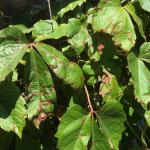
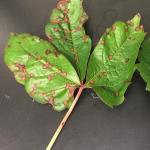
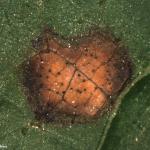 Guignardia leaf spot was diagnosed this week on a sample of Boston Ivy from Rhode Island. It was also observed on Boston Ivy (Parthenocissus tricuspidata) and another Parthenocissus species on the UMass campus. The infections are most likely caused by Guignardia bidwellii, the cause of black rot of grapes; however, it is believed Parthenocissus and Vitis are hosts to different strains of the fungus. Guignardia overwinters in infected plant tissue and proper management requires the removal of infected tissues on a regular basis. Prune vines to increase air circulation and facilitate drying of the canopy after rain. Remove nearby Virginia creeper (P. quinquefolia) if feasible as it may also be a host for the pathogen. (by Angela Madeiras)
Guignardia leaf spot was diagnosed this week on a sample of Boston Ivy from Rhode Island. It was also observed on Boston Ivy (Parthenocissus tricuspidata) and another Parthenocissus species on the UMass campus. The infections are most likely caused by Guignardia bidwellii, the cause of black rot of grapes; however, it is believed Parthenocissus and Vitis are hosts to different strains of the fungus. Guignardia overwinters in infected plant tissue and proper management requires the removal of infected tissues on a regular basis. Prune vines to increase air circulation and facilitate drying of the canopy after rain. Remove nearby Virginia creeper (P. quinquefolia) if feasible as it may also be a host for the pathogen. (by Angela Madeiras)
Maple anthracnose caused by Aureobasidium apocryptum, Discula campestris and Colletotrichum. Samples originated from multiple sites and trees, representing red maple (Acer rubrum), sugar maple (A. saccharum) and Japanese maple (A. palmatum). Dark-colored, spots and blotches were present on red maple leaves while sugar and Japanese maple exhibited brown spots and blotches. On one sample, two anthracnose fungi co-occurred: Discula campestris on the foliage and Colletotrichum on the samaras. Damage was severe in most cases and abundant throughout the canopy on established landscape trees.
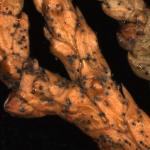 Arborvitae needle blight, caused by Phyllosticta thujae, on green giant arborvitae (Thuja standishii × plicata ′Green Giant′). Several trees, six-years-old, planted in May of 2015. Trees are provided with drip irrigation and receive half sun. Interior needles and the shoot tips became brown in early May and are prematurely shedding. Phyllosticta produces numerous pads of tissue that rupture through the surface of the needles and stems to release large volumes of clear spores.
Arborvitae needle blight, caused by Phyllosticta thujae, on green giant arborvitae (Thuja standishii × plicata ′Green Giant′). Several trees, six-years-old, planted in May of 2015. Trees are provided with drip irrigation and receive half sun. Interior needles and the shoot tips became brown in early May and are prematurely shedding. Phyllosticta produces numerous pads of tissue that rupture through the surface of the needles and stems to release large volumes of clear spores.
Verticillium wilt and stem cankering from Phomopsis on Japanese maple (Acer palmatum). Tree is roughly 15-years-old and has been present at the site for seven years. Several branches in one area of the canopy never produced foliage this spring. Fine twigs and stems had areas of graying and blackening bark, a typical symptom of stem cankering on this host. An olive-green discoloration was found in the xylem tissue on three-year-old stems and Verticillium was later incubated from the xylem tissue. The tree resides in full sun in a mulched bed with weed cloth surrounding the tree.
Cedar-quince rust, caused by Gymnosporangium clavipes and leaf and fruit blight caused by Colletotrichum on serviceberry (Amelanchier canadensis). The shrub is 10-years-old and has been present at the site for two years. New stems are distorted and curved due to infections by the cedar-quince rust fungus. Orange-colored pads of tissue were rupturing through the bark at the site of the stem cankers and rust-colored spores were observed. Cedar-quince rust can cause serious stem cankering and dieback on certain rosaceous hosts like serviceberry. The spores produced on rosaceous hosts will disperse to infect Juniperus. One reason why the disease is so difficult to treat is the long duration of spore dispersal from infected hosts, making fungicide timing difficult. In addition, the foliage and fruit were blighted and pink-colored masses of spores produced by Colletotrichum were abundant on the blighted tissues.
Report by Nick Brazee, Plant Pathologist, UMass Extension Plant Diagnostic Lab, UMass Amherst.
Insects
Woody ornamental insect and non-insect arthropod pests to consider, a selected few:
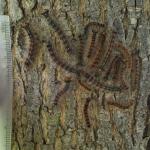
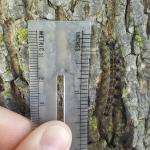
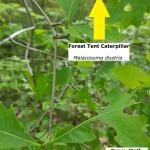
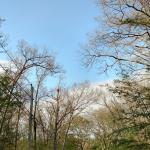 Gypsy Moth: Lymantria dispar caterpillars are in various sizes or developmental stages (instars) depending upon the location in Massachusetts. However, observations indicate that in many locations, these larvae are mostly in the 4th instar stage, however some 5th instars have been spotted. Male gypsy moth caterpillars go through 5 instars and female gypsy moth caterpillars have 6 instars. These caterpillars will continue to feed for the next couple of weeks, until they pupate, typically at the end of June. Male caterpillars will pupate just prior to the female caterpillars; pupation, like the transformation between the previous stages, does not happen all at once.
Gypsy Moth: Lymantria dispar caterpillars are in various sizes or developmental stages (instars) depending upon the location in Massachusetts. However, observations indicate that in many locations, these larvae are mostly in the 4th instar stage, however some 5th instars have been spotted. Male gypsy moth caterpillars go through 5 instars and female gypsy moth caterpillars have 6 instars. These caterpillars will continue to feed for the next couple of weeks, until they pupate, typically at the end of June. Male caterpillars will pupate just prior to the female caterpillars; pupation, like the transformation between the previous stages, does not happen all at once.
At this time and until the end of June, the defoliation they cause will be most noticeable. Reports made on 6/6/17 indicate that tree canopy thinning and complete defoliation were observed along I-90, approximately 4 miles east of Palmer, MA. On 6/15/17, a “55-65 MPH Survey” (driving along the MA Pike, I-90, on the way to a previously scheduled training) was conducted from the Westfield Exit (#3) to Exit 14 toward 95 south. Gypsy moth defoliation was highly visible beginning in Wilbraham while headed east through Palmer. On either side of the MA Pike, partial or complete defoliation (mostly oaks) could be seen. At mile marker 66.5 (just before) when headed downhill in the eastbound direction over the Quaboag River, there is a certain vantage point where you are at a higher elevation than the surrounding hillsides on either side of the highway. From that point of view, the defoliation was incredible. Large swaths on either side of the surrounding hills were covered in bare trees. When continuing east down I-90, the defoliation on either side of the highway continues through Sturbridge and roughly to the Charlton Plaza. From that point on, the defoliation was significantly less, at least on the trees visible from the highway. This trend continued roughly through Worcester, with any defoliation remaining in patches and certainly not to the extent of what was seen west of there. It seemed to not pick up again until roughly mile marker 98 and then was sporadic and relatively light (again, when thinking about the previously described areas) until you reach Hopkinton and Exit 11A to 495. Defoliation in that area seemed again analogous to what was seen from Wilbraham to the Charlton plaza. By mile marker 108.7, defoliation dropped to sporadic, light patches again. This limited, quick survey ended at Exit 14 and no samples of caterpillars were taken at that time due to safety concerns and time limits. However, it will be interesting to see what the 2017 aerial survey maps from the MA Department of Conservation and Recreation look like for defoliation this year.
Caterpillars are actively crawling up and down tree trunks, a behavior which makes them more likely to be exposed to pathogens, including the fungus, Entomophaga maimaiga. Reports of the sound of frass (excrement) dropping from the canopy where these caterpillars are feeding have been made. (The sound of frass dropping could be heard in Belchertown on 6/9/17 and Hanson on 6/15/17.) Roughly, 1- 1.5-inch long gypsy moth caterpillars have been observed resting or crawling on tree trunks and branches in Amherst as of 6/14/17. These caterpillars are dark in color, hairy, and the “warts” have developed to include the characteristic blue and red coloration, along with a head capsule that is yellow and mottled with black markings. In areas where gypsy moth caterpillars are abundant, citizens are dealing with caterpillars crawling all over the sides of homes, sheds, lawn furniture, and dropping from these locations and nearby trees. Caterpillars may be found on driveways, along with shredded sections of leaves due to their feeding, which are easily visible against that background. In Amherst on 6/12/17, caterpillars were found in a cluster, hidden behind a sign that was leaned up against a Norway maple. The sign was moved from the shaded area beneath the tree to a location in full sun, in order to inspect the cluster of caterpillars on the tree. In moments, the sun heated the sign and 50+ caterpillars came crawling down from where they were hidden along the edges of said sign. See the Regional Reports above for more information about gypsy moth activity.
According to prior reports from the Elkinton Lab, successful infection of gypsy moth caterpillars with the insect-killing fungus Entomophaga maimaiga, has begun. It is important to note that even with fungal infection in the caterpillars, we may still see significant defoliation in certain areas of Massachusetts this year due to this insect. Dr. Joseph Elkinton and his lab group, along with other local cooperators, are conducting a study that he is referring to as the “Cloud of Death Experiment”! What Dr. Elkinton means by this is that the research will aim to detect the amount of air-borne spores of the Entomophaga maimaiga fungus in certain locations of Massachusetts throughout the rest of the 2017 caterpillar activity (roughly through June). He and his lab hope to compare this to a measurement of the caterpillars killed at these various locations while determining if the fungus (or virus) is responsible. The Elkinton Lab has sites in Amherst, Belchertown, Brewster, Eastham, Hanson, and West Bridgewater to conduct these observations. To date, they have reported fungal activity at some of these sites, now with approximately 30% mortality due to Entomophaga maimaiga observed in caterpillars being reared on artificial diets (in the lab) collected from these sites. Anecdotally in the field, however, some reports of gypsy moth caterpillars “disappearing in large numbers” have been made at various locations across the state. This may be, in part, due to the behavior change that occurs when caterpillars reach the 4th instar. If an observer is used to seeing the caterpillars actively feeding on foliage during the day, they may be surprised to find them missing. The 4th instar caterpillars will change their behavior such that they feed at night, while hiding during the day. That being said, in high populations, even 4th instar caterpillars will feed at any time, daytime included. Fungal spores were isolated from a caterpillar collected from Belchertown on 6/9/17; however, the majority of the (many) caterpillars observed on that date were healthy and actively feeding (even during the day) at that location. Reports of caterpillar dieback at a location in Marlborough were also made on 6/15/17. The Elkinton Lab expects the percentage of caterpillars killed by the fungus will increase, but unfortunately, we cannot determine at this time how large of an impact the fungus will have on gypsy moth this year. Look to the Landscape Message for continued updates about Dr. Elkinton’s research as well as reports concerning the activity of Entomophaga maimaiga in Massachusetts.
To treat individual, landscape ornamental and shade trees, spinosad is effective on younger and older gypsy moth caterpillars (over ¾ inch in length) but should not be applied to plants while they are in bloom due to the risk toward pollinators.
Gypsy moth host plants include but are not limited to oak (favored), maple, birch, poplar, and many others. Caterpillars will feed on conifers (such as eastern white pine, hemlock, and spruce) when favored resources have been exhausted. Gypsy moth damage has also been reported on blueberry crops in Massachusetts this year.
Patchy areas across mostly central and eastern Massachusetts experienced elevated populations of gypsy moth and significant amounts of defoliation in 2016 (see the Insects section of the archived 2016 Landscape Messages between April 29 and July 29). The Massachusetts Department of Conservation and Recreation aerially mapped approximately 350,000 acres of defoliation across Massachusetts last year, attributed to gypsy moth. State officials warn the public about another year of defoliation from gypsy moth as predicted for 2017: http://www.mass.gov/eea/agencies/dcr/pr-2017/another-year-of-defoliation-from-gypsy-moth-in-2017.html. That web page also links to a map of the 2016 defoliation from gypsy moth, which may provide a reference regarding areas that may be impacted by this insect again in 2017.
We can also hope areas in Massachusetts that did not experience much gypsy moth defoliation last year (areas such as most of Berkshire County) will be mostly spared in 2017 in comparison to those areas who suffered last year in southern central and eastern Massachusetts. However, due to the ballooning ability of the young caterpillars, where egg masses may exist nearby, previously unaffected host plants may be found to have gypsy moth caterpillars present on them this year. For more information about gypsy moth, please visit: http://ag.umass.edu/landscape/fact-sheets/gypsy-moth and return to the Landscape Message for timely updates about this pest and others throughout the season. An excellent article written by Dr. Joseph Elkinton and Jeff Boettner of the University of Massachusetts about the 2016 outbreak and the history of this insect in Massachusetts may be found here: http://www.mass.gov/eea/agencies/dfg/dfw/publications/gypsy-moth-outbreak-of-2016.html
- Azalea Bark Scale: Eriococcus azaleae was discovered in CT in 1917 and has since been reported in other states. It is found on the bark of twigs and stems and commonly settles in branch crotches. It has been reported on azalea, rhododendron, andromeda, and others. Female scales are approximately 2-3 mm. in length and covered in a white, waxy coating. The females are purple in color and may resemble a mealybug, although they are a soft or felt scale. These females have overwintered and are going to lay eggs which will hatch into crawlers toward the end of June through mid-July. Crawlers will settle into branch crotches, bark crevices, or on the axils of leaves. There is a parasitic wasp that will attack these insects. When high in number, these scales can cause yellowing of the foliage and their sugary excrement can lead to the promotion of sooty mold. Because these are soft scales, they may be targeted with horticultural oils or insecticidal soaps while observing label instructions to prevent phytotoxicity.
- Black Vine Weevil: Otiorhynchus sulcatus damage is apparent on rhododendron and taxus, but can also be seen on azalea, mountain laurel, and Euonymus. Adult weevils feed along the leaf/needle margins and create rounded notches. Inspect foliage of these plants for notching from last season’s feeding. Adults emerge in June and create new damage to leaves for this season. All individuals are females and reproduce asexually. This insect has developed resistance to many chemical insecticides. Entomopathogenic nematodes such as Steinernema carpocapsae, S. feltiae, and Heterorhabditis bacterio-phora work well against this insect, particularly on containerized plants. Results in the landscape vary. Wetting the soil thoroughly prior to application and keeping it wet for at least 5 days following application can help increase the efficacy of the nematodes. Burlap laid around the base of plants during the time adults are active, through August, can be inspected weekly for adult weevils which can be killed before egg laying.
- Cottony Taxus Scale: Chloropulvinaria floccifera, also referred to as the cottony camellia scale, utilizes such hosts as taxus, camellia, holly, hydrangea, Japanese maple, euonymus, magnolia, jasmine, and Callicarpa americana. This insect was observed on taxus in Amherst on 5/31/17. Females are laying the long, narrow, white colored egg sac that makes them much more noticeable. This was observed again on 6/8/17 and 6/14/17. Eggs will hatch over an extended period of 6 weeks and crawlers may be treated between 802-1388 GDD’s. This insect can cause the host to appear off-color. They also produce honeydew which promotes sooty mold growth. Target the underside of the foliage. Horticultural oil, neem oil, and insecticidal soaps may be used to manage these soft scales. They may also be washed from plants with a strong jet of water.
- Eastern Tent Caterpillar: Malacosoma americanum (ETC) impacts cherry, crabapple, apple, ash, birch, willow, maple, oak, poplar, and witch-hazel. Pupation of this insect will begin in June and last for a few weeks. Adults are typically seen in late June - early July. At a site being monitored in Westfield, MA, the tents of ETC are vacant and the caterpillars are nowhere to be found. Due to the amount of poison ivy at the site, closer inspection for pupae was not possible; however, it is suspected that the caterpillars at that location have begun to pupate.
- Elongate Hemlock Scale: Fiorinia externa is found on eastern, Carolina, and Japanese hemlock, as well as yew, spruce, and fir. Crawlers will be present throughout the growing season and the overlap of many developmental stages at any given time can be observed.
- Emerald Ash Borer (EAB): Agrilus planipennis readily attacks ash (Fraxinus spp.) including white, green, and black ash and has also been found developing in white fringe tree (Chionanthus virginicus) and most recently, cultivated olive (Olea europaea). (See: https://academic.oup.com/jee/article-lookup/doi/10.1093/jee/tox139.) Adult insects of this species are emerging at this time, as we have surpassed in most areas of the state 450-550 GDD’s (see Environmental Data above). Anyone monitoring for emerald ash borer using traps and lures should have them deployed at this time (if they have not already), otherwise they risk missing adult beetle activity. Signs of an EAB infested tree may include D-shaped exit holes in the bark, “blonding” or lighter coloration of the ash bark from woodpecker feeding (chipping away of the bark as they search for larvae beneath), and serpentine galleries visible through splits in/upon peeling the bark, from larval feeding beneath. Positive identification of an EAB-infested tree may not be possible with these signs individually on their own.
For a map of the known locations of emerald ash borer in the state, as well as further information about this insect, please visit: https://ag.umass.edu/fact-sheets/emerald-ash-borer. If you believe you have located EAB-infested ash trees, particularly in an area of Massachusetts not identified on the map provided, please report it at the Massachusetts Introduced Pests Outreach Project: http://massnrc.org/pests/pestreports.htm
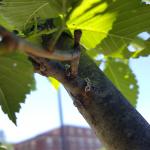 European Elm Scale: Gossyparia spuria is a type of felt scale and was observed on an elm on 6/7/17 and 6/14/17 in Amherst. First noted in New York in 1884, this non-native scale is now widespread in North America and is found on native and European elms, but also rarely on hackberry and Zelkova. This insect can cause yellowing of foliage, premature leaf drop, and eventually dieback on its host. Honeydew and thus sooty mold are produced. The females observed in Amherst have produced a ring of white fibers around their black, oval bodies. By the end of June, these females will lay eggs that hatch into bright yellow crawlers, which will disperse to the midrib and leaf veins on the underside of elm leaves where they will remain to feed. Crawlers are tiny and magnification is necessary to observe. Natural enemies such as parasitic wasps and predatory insects have been reported as successful in managing this insect.
European Elm Scale: Gossyparia spuria is a type of felt scale and was observed on an elm on 6/7/17 and 6/14/17 in Amherst. First noted in New York in 1884, this non-native scale is now widespread in North America and is found on native and European elms, but also rarely on hackberry and Zelkova. This insect can cause yellowing of foliage, premature leaf drop, and eventually dieback on its host. Honeydew and thus sooty mold are produced. The females observed in Amherst have produced a ring of white fibers around their black, oval bodies. By the end of June, these females will lay eggs that hatch into bright yellow crawlers, which will disperse to the midrib and leaf veins on the underside of elm leaves where they will remain to feed. Crawlers are tiny and magnification is necessary to observe. Natural enemies such as parasitic wasps and predatory insects have been reported as successful in managing this insect.
- Fletcher Scale: Parthenolecanium fletcheri (soft scale) was observed on taxus (yew) in Amherst on 6/8/17 and 6/14/17. Several effective parasites will impact these scale populations and any management decisions should seek to preserve them. Dead, desiccated female scales appear at this time as covers (test) that one might expect from an armored scale and should not be confused for one. When removed, it is easy to find hundreds of tiny, white colored eggs beneath the female (you will need a hand lens to observe). This scale is commonly found on yew and arborvitae (but has also been reported on juniper and hemlock). It may be confused with the European fruit lecanium (P. corni), which has a much broader host range. Depending upon the host plant, crawlers of the fletcher scale will hatch by the end of June and management may be targeted between 1029-1388 GDD’s, base 50°F. Large populations of this scale may lead to host plant yellowing, premature needle drop, and production of honeydew giving way for sooty mold. Each female produces on average 500-600 eggs. The degree of impact this insect may have depends on the host. Some hosts, such as yew, are reportedly more heavily impacted by this scale as when compared to arborvitae, where visible damage may be seldom. Horticultural oil, insecticidal soap, or neem oil may be used according to label instructions in order to preserve natural enemies.
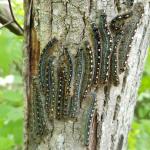 Forest Tent Caterpillar: Malacosoma disstria (FTC) caterpillars continue to feed on maple and oak. Other susceptible hosts such as birch, ash, elm, poplar, and basswood may also be fed upon by these caterpillars. These native insects can defoliate their host plants, but are not currently in large populations in all areas in the state. At a location in Amherst, FTC’s were observed to have perished due to a fungus (different species of Entomophaga affect these native caterpillars than the one found in gypsy moth). At a location in Belchertown on 6/9/2017, many large FTC’s were observed feeding alongside gypsy moth caterpillars. Pupation of forest tent caterpillars will begin soon, but they are still actively feeding at this time.
Forest Tent Caterpillar: Malacosoma disstria (FTC) caterpillars continue to feed on maple and oak. Other susceptible hosts such as birch, ash, elm, poplar, and basswood may also be fed upon by these caterpillars. These native insects can defoliate their host plants, but are not currently in large populations in all areas in the state. At a location in Amherst, FTC’s were observed to have perished due to a fungus (different species of Entomophaga affect these native caterpillars than the one found in gypsy moth). At a location in Belchertown on 6/9/2017, many large FTC’s were observed feeding alongside gypsy moth caterpillars. Pupation of forest tent caterpillars will begin soon, but they are still actively feeding at this time.
- Hemlock Looper: Two species of geometrid moths in the genus Lambdina are native insects capable of defoliating eastern hemlock, balsam fir, and white spruce. Adult moths lay their eggs on the trunk and limbs of hosts in September and October, and eggs hatched in early June. Monitor susceptible hosts for small, inch-worm like caterpillars. Where populations are low, no management is necessary. Anecdotal reports of increasing hemlock looper populations in certain areas of western Massachusetts (Berkshire County) have been made this season.
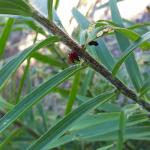

 Lily Leaf Beetle: Lilioceris lilii adult beetles were still causing feeding damage, mating, and eggs were laid on plants in Amherst on 6/14/17. More frass or excrement-covered larvae of this insect were also found feeding in Amherst at this time. These larvae are growing ever-larger and are completely devouring leaves; whereas their smaller counterparts are still skeletonizing. See Regional Reports for local activity of this insect. Management can be achieved by hand-picking and removing adults and larvae. Some chemical management options are available for this insect, but if caught early mechanical management may be effective. (Although when many plants are involved, mechanical management may not be practical.)
Lily Leaf Beetle: Lilioceris lilii adult beetles were still causing feeding damage, mating, and eggs were laid on plants in Amherst on 6/14/17. More frass or excrement-covered larvae of this insect were also found feeding in Amherst at this time. These larvae are growing ever-larger and are completely devouring leaves; whereas their smaller counterparts are still skeletonizing. See Regional Reports for local activity of this insect. Management can be achieved by hand-picking and removing adults and larvae. Some chemical management options are available for this insect, but if caught early mechanical management may be effective. (Although when many plants are involved, mechanical management may not be practical.)
The University of Rhode Island Biological Control Lab is researching ways to find a natural method to combat these beetles. Small parasitic insects have been established in lily plots in Cumberland, RI and Wellesley, MA in hopes that these insects will disperse naturally to reduce the effects of the lily leaf beetle. If you have larvae in your yard (or a customer’s yard), please send to URI, following the instructions on the URI Biocontrol Lab website: http://web.uri.edu/biocontrol/home/lily-leaf-beetle-larval-collections-2016-mailing-instructions/
- Roseslugs: These small, caterpillar-like sawfly larvae will skeletonize the upper leaf surface and leave a “window-pane” like pattern behind. When present in large numbers, these insects are capable of defoliating their entire host. Management options include an insecticidal soap spray or a product containing spinosad. One species, Allantus cinctus, may require management again in mid-August; otherwise the window for management will pass typically by mid-June.
- Taxus Mealybug: Dysmicoccus wistariae was spotted on taxus in Amherst on 5/31/17, 6/8/17, and 6/14/17. This insect will produce honeydew and lead to sooty mold growth, yellowing of needles, and sparsely foliated plants. Eventual dieback may be possible. This species is commonly associated with taxus in New England, but can be occasionally found on dogwood, rhododendron, Prunus spp., maple, andromeda, and crabapple. These mealybugs are found on stems and branches and particularly like to congregate at branch crotches. Management may be targeted between 246-618 GDD’s. Horticultural oil and neem oil may be used.
 Two-marked Tree Hopper: The Enchenopa binotata species complex is now thought to be made up of very closely related Enchenopa spp. that are morphologically very similar but separated by the different host plants that they are found on. These particular treehoppers are found on black walnut, wafer ash (Ptelea trifoliata), and viburnum. These insects will feed on the host plants with piercing-sucking mouthparts and drink plant juices from the leaves and petioles. Leaves will become shiny and sticky with their excrement. (This was observed for the first time in Amherst on 6/14/17, although the nymphs have been active for quite some time now this season.) Still small nymphs have been observed on wafer ash in Amherst. Eggs are laid by adult females using saw-like ovipositors to insert them into plant stems. Eggs are then covered with a vivid white, sticky, frothy material that protects them but can easily be mistaken for a scale insect. Eggs have hatched and the tiny, young nymphs can be seen feeding at this time. These treehoppers, whether by their feeding activity or egg laying behavior into plant stems, are not considered to be damaging pests (even when high in numbers) and therefore management is generally not required.
Two-marked Tree Hopper: The Enchenopa binotata species complex is now thought to be made up of very closely related Enchenopa spp. that are morphologically very similar but separated by the different host plants that they are found on. These particular treehoppers are found on black walnut, wafer ash (Ptelea trifoliata), and viburnum. These insects will feed on the host plants with piercing-sucking mouthparts and drink plant juices from the leaves and petioles. Leaves will become shiny and sticky with their excrement. (This was observed for the first time in Amherst on 6/14/17, although the nymphs have been active for quite some time now this season.) Still small nymphs have been observed on wafer ash in Amherst. Eggs are laid by adult females using saw-like ovipositors to insert them into plant stems. Eggs are then covered with a vivid white, sticky, frothy material that protects them but can easily be mistaken for a scale insect. Eggs have hatched and the tiny, young nymphs can be seen feeding at this time. These treehoppers, whether by their feeding activity or egg laying behavior into plant stems, are not considered to be damaging pests (even when high in numbers) and therefore management is generally not required.- Viburnum Leaf Beetle: Pyrrhalta viburni is a beetle in the family Chrysomelidae that is native to Europe, but was found in Massachusetts in 2004. See the Regional Reports regarding areas where this insect has been noted to be active this season. At this time, larvae have dropped to the soil to pupate and adult beetles will be present in late-June through roughly October, or when the first frost hits. Adult beetles will create their own feeding damage, but will also mate and females will lay eggs in the stems of the viburnums, typically beginning in late-June to mid-July until October. This beetle feeds exclusively on many different species of viburnum including but not limited to susceptible plants such as V. dentatum, V. nudum, V. opulus, V. propinquum, and V. rafinesquianum. Larvae may be treated with a product containing spinosad. Some viburnum have been observed to have varying levels of resistance to this insect, including but not limited to V. bodnantense, V. carlesii, V. davidii, V. plicatum, V. rhytidophyllum, V. setigerum, and V. sieboldii. More information about viburnum leaf beetle may be found at http://www.hort.cornell.edu/vlb/.
- White Spotted Pine Sawyer (WSPS): Monochamus scutellatus adults have been previously reported from Middlesex, Plymouth, and Worcester counties in MA. (One was also observed in Jaffrey, NH while hiking in Monadnock State Park on Saturday, June 3.) Adults will continue to be active through July. This is a native insect in Massachusetts and is usually not a pest. Larvae develop in weakened or recently dead conifers, particularly eastern white pine (Pinus strobus). However, the white spotted pine sawyer looks very similar to the invasive Asian Longhorned Beetle, Anoplophora glabripennis, ALB. ALB adults do not emerge in Massachusetts until July and August. Beginning in July, look for the key difference between WSPS and ALB adults, which is a white spot in the top center of the wing covers (the scutellum) on the back of the beetle. White spotted pine sawyer will have this white spot, whereas Asian longhorned beetle will not. Both insects can have other white spots on the rest of their wing covers; however, the difference in the color of the scutellum is a key characteristic. See the Asian longhorned beetle entry below for more information about that non-native insect.
- Woolly Elm Aphid: Eriosoma americanum is most likely the species responsible for the distorted and curled leaves observed on a plant in Amherst on 6/7/17 and again on 6/14/17. This particular aphid is known to have alternate hosts that it utilizes on a yearly basis. Elm is the overwintering and spring-time host, and by the end of June the winged, migrating generation leaves the elm in search of the roots of Amelanchier. The best time to manage for this aphid has passed (121-246 GDD, base 50°F) and although abundant, the individuals are well protected within the curled and distorted leaves at this time. This particular plant was also highly attractive to adult multicolored Asian lady beetles who were seen mating and scurrying along branches.
- Chilli Thrips: *A non-native insect has been confirmed in Massachusetts for the first time.* The non-native, exotic chilli thrips (Scirtothrips dorsalis) has been confirmed from two samples of damaged Hydrangea spp. foliage from two residential landscapes located in Barnstable County, MA submitted to the UMass Plant Diagnostics Laboratory. At this time, this pest has not been confirmed in nurseries or greenhouses in Massachusetts or on any other host plants. Due to the limited number of samples, the significance of chilli thrips in Massachusetts is not yet known. This species of thrips is a significant global pest of economically important ornamental, vegetable, and fruit crops in southern and eastern Asia, Oceania, and parts of Africa. It was first determined to be established in the United States in 2005 in Florida, although previous interceptions of this pest were detected. It is reportedly a pest of over 100 host plants belonging to over 40 plant families, including, but not limited to, pepper, strawberry, blueberry, cotton, rose, peanut, Japanese privet, Rhododendron spp., Viburnum spp., eggplant, grapes, melon, tobacco, and tomato. For more information, please visit this Chilli Thrips Fact Sheet (https://ag.umass.edu/landscape/fact-sheets/chilli-thrips) available on the UMass Extension Landscape, Nursery, and Urban Forestry Program web page.
- Asian Longhorned Beetle, Anoplophora glabripennis, ALB: Look for signs of an ALB infestation which include perfectly round exit holes (about the size of a dime), shallow oval or round scars in the bark where a female has chewed an egg site, or sawdust-like frass (excrement) on the ground nearby host trees or caught in between branches. Be advised that other, native insects may create perfectly round exit holes or sawdust-like frass, which can be confused with signs of ALB activity.
The regulated area for Asian longhorned beetle is 110 miles2 encompassing Worcester, Shrewsbury, Boylston, West Boylston, and parts of Holden and Auburn. If you believe you have seen damage caused by this insect, such as exit holes or egg sites, on susceptible host trees like maple, please call the Asian Longhorned Beetle Eradication Program office in Worcester, MA at 508-852-8090 or toll free at 1-866-702-9938. Adult insects of this species will not be present until July.
To report an Asian longhorned beetle find online or compare it to common insect look-alikes, visit: http://massnrc.org/pests/albreport.aspx or https://www.aphis.usda.gov/pests-diseases/alb/report.
Concerned that you may have found an invasive insect or suspicious damage caused by one? Need to report a pest sighting? If so, please visit the Massachusetts Introduced Pests Outreach Project: http://massnrc.org/pests/pestreports.htm.
Pollinator Protection Resource Online: The Massachusetts Department of Agricultural Resources has developed a Massachusetts Pollinator Protection Plan. It is a set of voluntary guidelines that discuss best management practices for stakeholders seeking to promote the health of the European honeybee and other pollinators. This document includes information for beekeepers, pesticide applicators, land managers and farmers, nurseries and landscapers, and homeowners and gardeners. Please locate the MA Pollinator Protection Plan for more information here: http://www.mass.gov/eea/docs/agr/farmproducts/apiary/pollinator-plan.pdf.
A note about Tick Awareness: deer ticks (Ixodes scapularis), the American dog tick (Dermacentor variabilis), and the lone star tick (Amblyomma americanum) are all found throughout Massachusetts. Each can carry their own complement of diseases. Anyone working in tick habitats (wood-line areas, forested areas, and landscaped areas with ground cover) should check themselves regularly for ticks while practicing preventative measures. Have a tick and need it tested? Visit the web page of the UMass Laboratory of Medical Zoology (www.tickdiseases.org) and click on the red Test a Tick button for more information.
For information about managing ticks in landscapes, among other topics, please visit the following publication from the Connecticut Agricultural Experiment Station: “Tick Management Handbook”: http://www.ct.gov/caes/lib/caes/documents/publications/bulletins/b1010.pdf.
Report by Tawny Simisky, Extension Entomologist, UMass Extension Landscape, Nursery, & Urban Forestry Program
Management Practices
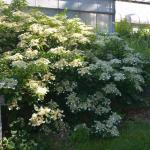

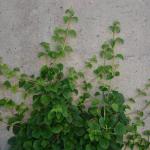 Plant of the Week: Hydrangea anomala subsp. petiolaris
Plant of the Week: Hydrangea anomala subsp. petiolaris
Hydrangea anomala subsp. petiolaris is a deciduous climbing vine native to Japan and China. Main stems climb vertically along sturdy structures or buildings while side branches grow horizontally. Climbing hydrangea can be grown as a 3-4’ mound if planted without a structure to grow on, but can reach 30’ or more as a vine when supported. The large fragrant, lacecap flower clusters are very showy against the dark green foliage in early June. The flower corymbs grow up to 10” wide and consist of non-showy fertile flowers surrounded by the showy sterile flowers. The dark green, glossy leaves are broad ovate with serrated margins. Fall color can be yellow, but leaves often remain green until they fall in autumn. Bark is exfoliating reddish brown and provides winter interest. Hydrangea anomala subsp. petiolaris has no serious insect or disease issues but needs a strong structure if grown on walls, fences, or other supports. Plants climb via aerial rootlets, or “holdfasts” and be twining. Appropriate siting is important for plant vigor and establishment. Plants are best grown in a fertile, moist, well-drained soil in full sun to part shade on a north or east side of a building. Hot, dry sites should be avoided. Climbing hydrangea can be slow to establish but is a great, multi-season vine for the landscape.
Report by Mandy Bayer, Extension Assistant Professor of Sustainable Landscape Horticulture, UMass Stockbridge School of Agriculture
Additional Resources
To receive immediate notification when the next Landscape Message update is posted, be sure to join our e-mail list and follow us on Facebook and Twitter.
For a complete listing of upcoming events, see our Upcoming Educational Events page.
For commercial growers of greenhouse crops and flowers - Check out the New England Greenhouse Update website
For professional turf managers - Check out Turf Management Updates
For home gardeners and garden retailers - Check out home lawn and garden resources. UMass Extension also has a Twitter feed that provides timely, daily gardening tips, sunrise and sunset times to home gardeners, see https://twitter.com/UMassGardenClip
Diagnostic Services
A UMass Laboratory Diagnoses Landscape and Turf Problems - The UMass Extension Plant Diagnostic Lab is available to serve commercial landscape contractors, turf managers, arborists, nurseries and other green industry professionals. It provides woody plant and turf disease analysis, woody plant and turf insect identification, turfgrass identification, weed identification, and offers a report of pest management strategies that are research based, economically sound and environmentally appropriate for the situation. Accurate diagnosis for a turf or landscape problem can often eliminate or reduce the need for pesticide use. For sampling procedures, detailed submission instructions and a list of fees, see Plant Diagnostics Laboratory
Soil and Plant Nutrient Testing - The University of Massachusetts Soil and Plant Nutrient Testing Laboratory is located on the campus of The University of Massachusetts at Amherst. Testing services are available to all. The function of the Soil and Plant Nutrient Testing Laboratory is to provide test results and recommendations that lead to the wise and economical use of soils and soil amendments. For complete information, visit the UMass Soil and Plant Nutrient Testing Laboratory web site. Alternatively, call the lab at (413) 545-2311.
Ticks are active at this time! Remember to take appropriate precautions when working and playing outdoors, and conduct daily tick checks. UMass tests ticks for the presence of Lyme disease and other disease pathogens. Learn more
